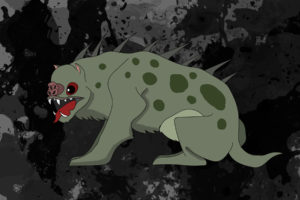Chupacabra (choo-pah-kah-brah)
 Chupacabras (Choo-pah-kah-brah) were perhaps the most unique creatures on Fabella. Their strict diet of blood caused their DNA to change over time and become infused with the DNA of their hosts. This biological oddity results in chupacabras adopting biological characteristics of those creatures whose blood they dined on the most. No two chupacabras were the same. If one drank enough blood from a person, they could actually walk and talk like a human. This eventually resulted in the inspiration and popularity of the vampire myth. Famous chupacabras included Count Dracula, the Jersey Devil, and — of course — Tefnut.
Chupacabras (Choo-pah-kah-brah) were perhaps the most unique creatures on Fabella. Their strict diet of blood caused their DNA to change over time and become infused with the DNA of their hosts. This biological oddity results in chupacabras adopting biological characteristics of those creatures whose blood they dined on the most. No two chupacabras were the same. If one drank enough blood from a person, they could actually walk and talk like a human. This eventually resulted in the inspiration and popularity of the vampire myth. Famous chupacabras included Count Dracula, the Jersey Devil, and — of course — Tefnut.
Chupacabras fed almost exclusively on blood. Whose blood didn’t really matter. All they wanted was a taste of the red stuff. They were also known to feast on animal flesh from time to time, but this was only to satisfy their carnivorous appetite and get at pockets of blood which might still be in the meat. No chupacabra was ever seen eating vegetables. In fact, they abhorred all produce. This was where the stereotype of garlic being used to ward off vampires came from.
No matter which form they were in, all chupacabras were born as gray hairless pups who looked like naked mole rats in appearance. Family units varied. Most females were single parents. Males had a sporadic involvement in raising their young.
Children born from a union between a chupacabra and a person traditionally were born as a person. Practically all genes from a person were more dominant than those weak genes from a chupacabra. Part chupacabran offspring were sometimes born with animal like features. Take the character of Thoth, for example, with his bird-like hooked nose, heightened brain power over other people, and uncanny talent to mimic animal noises.
A chupacabra’s anatomy was ever shifting. Bones could grow or shrink depending on how much blood from a certain animal was drunk. They could even grow organs. This was especially useful in the medical industry, because hospitals could use chupacabras to grow organs for transplant. This process was frowned upon by the Animal Rights community, and many activists sought to have this practice outlawed.
